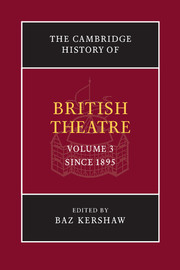Book contents
- Frontmatter
- Part I 1895–1946
- 1 British theatre, 1895–1946: art, entertainment, audiences – an introduction
- 2 The London stage, 1895–1918
- 3 Provincial stages, 1900–1934: touring and early repertory theatre
- 4 Popular theatre, 1895–1940
- 5 Case study: Cicely Hamilton’s Diana of Dobson’s, 1908
- 6 A critical year in perspective: 1926
- 7 The London stage, 1918–1945
- 8 Social commitment and aesthetic experiment, 1895–1946
- Part II Scottish and Welsh Theatres, 1895–2002
- Part III 1940–2002
- Bibliography
- Index
- References
6 - A critical year in perspective: 1926
from Part I - 1895–1946
Published online by Cambridge University Press: 28 March 2008
- Frontmatter
- Part I 1895–1946
- 1 British theatre, 1895–1946: art, entertainment, audiences – an introduction
- 2 The London stage, 1895–1918
- 3 Provincial stages, 1900–1934: touring and early repertory theatre
- 4 Popular theatre, 1895–1940
- 5 Case study: Cicely Hamilton’s Diana of Dobson’s, 1908
- 6 A critical year in perspective: 1926
- 7 The London stage, 1918–1945
- 8 Social commitment and aesthetic experiment, 1895–1946
- Part II Scottish and Welsh Theatres, 1895–2002
- Part III 1940–2002
- Bibliography
- Index
- References
Summary
This, then, is the situation in 1926. Alarge part of the London theatre is given up to plays about dope fiends and jazz-maniacs; other large tracts are abandoned to the inanities of musical comedy. Roughly speaking, three-fourths of the London stage is closed to persons possessed of the slightest particle of intellect or the least feeling for the drama …Yet – and this is the thing I want most to say – there never was a time when the general interest in, and preoccupation with, the drama was bigger both in London and throughout the country
Britain came closer to outright class war in 1926 than at any other time in the twentieth century, and theatre, as one of the principal media through which ideas were disseminated, was a crucial battleground in the struggle. A few years earlier, a play called The Right to Strike had led to arguments and fighting in the auditorium, articles in the Times, polls by the Daily Mirror, extracts being performed in church, and the intervention of Buckingham Palace. ‘One feels’, wrote the Saturday Review, that the author, if he had liked to do so, might quite easily have provoked a riot’. It is only necessary to see how concerned the Censors were about licensing plays for public performance to realise how significant theatre was seen to be in preventing or encouraging class conflict. In 1925 a licence had been refused to Strindberg’s Miss Julie partly because of its ‘very questionable theme in these days of the relations between masters and servants’, and in 1926 Noel Coward’s This Was a Man suffered the same fate at the hands of the Lord Chamberlain and his Advisory Board:
Every character in this play, presumably ladies and gentlemen, leads an adulterous life and glories in doing so. The only exceptions are two servants who are kept busy mixing cocktails. I find no serious purpose in the play, unless it be misrepresentation. At a time like this what better propaganda could the Soviet instigate and finance?
- Type
- Chapter
- Information
- The Cambridge History of British Theatre , pp. 127 - 142Publisher: Cambridge University PressPrint publication year: 2004

